James Golden says he is a New American gardener. By this he means he mimics nature by planting large swaths of plants, following in the footsteps of such greats as Wolfgang Oehme, James van Sweden and Piet Oudolf.
Golden is a brave gardener, experimenting with unfamiliar plants and using stalwart plants in new ways. All of this makes his garden a worthy destination and an unforgettable experience. I recently visited Golden’s New Jersey garden, named The Garden at Federal Twist, on a Garden Conservancy Open Days tour. Let’s take a look.
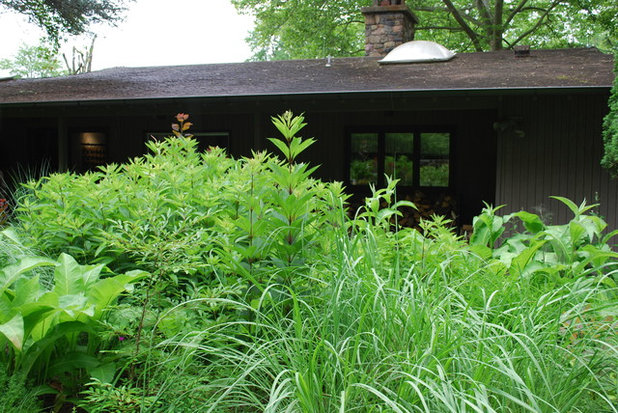
Jay Sifford Garden Design
Garden at a GlanceWho lives here: James Golden and Phillip Saperia
Location: Stockton, New Jersey
Size: 1½ acres
Golden and Saperia purchased their midcentury modern home in late 2005. When the home was built in 1965, it sat atop an open field, which over the years had become overgrown with more than 80 scraggly cedars not indigenous to this land.
Golden had the trees removed to create a canvas for his garden, which he started one year after moving into the house. He planned a garden with dimensions based on the height of the house, inspired by the British garden designer John Brookes.
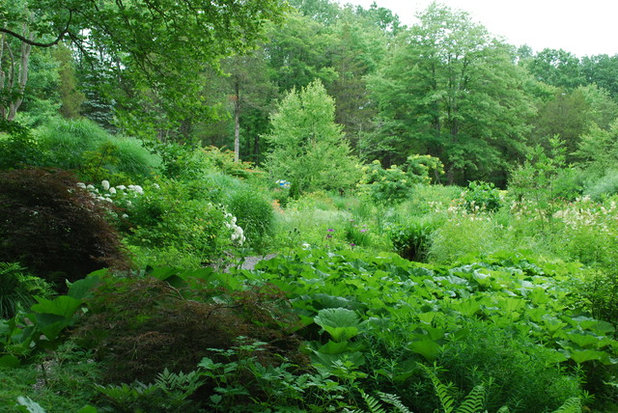
Jay Sifford Garden Design
From early on, Noel Kingsbury’s book
The New Perennial Garden influenced Golden’s design, and he started planting perennials directly into the existing rough grass. The soil in the garden is a heavy clay and is saturated most of the year. Instead of attempting to amend such a large amount of heavy soil, he decided to embrace the challenge of finding out what would grow there. Early plantings succumbed to deer, so a deer fence was installed along the perimeter of the property.
Golden has no formal training in landscape design, but he had experimented with plants and design in a small Brooklyn city garden, which he still owns, before starting work on this garden. This photo shows the bog garden as visitors enter the space from a side yard.
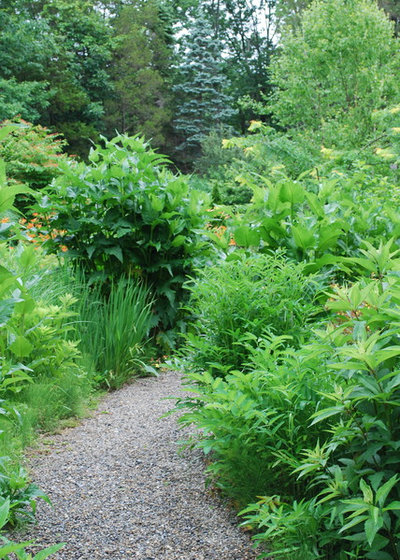
Jay Sifford Garden Design
After clearing the land, Golden laid out a central path to circle the property, shown here. During this process he discovered a bog in a low point on the property and a series of banks closer to the house, previously hidden by undesirable vegetation. This discovery of a woodland edge and a wetland led Golden to what he describes as a new way of thinking about plants: their appropriateness for their conditions.
He quit trying to force plants to grow where they pouted, instead seeking out plants suited to grow in this heavy, wet soil. He found that many prairie plants, such as great coneflower (
Rudbeckia maxima, USDA zones 4 to 9; find your zone) and Queen of the Prairie (
Filipendula rubra,
zones 3 to 6), adapted quite well to his soil because of their deep root structure.
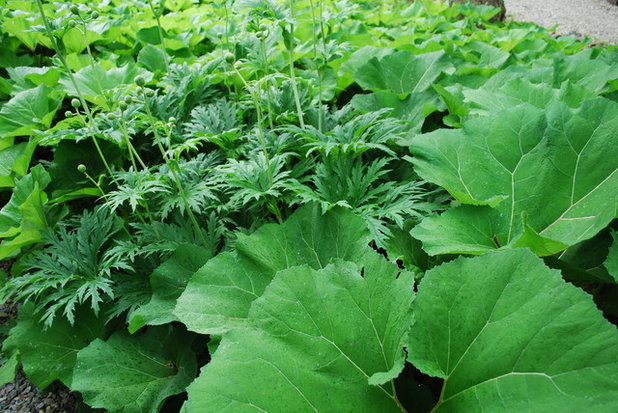
Jay Sifford Garden Design
Golden is a gardener who holds plant texture, foliage, structure and form in high esteem. Flowers, he says, are a bonus. Plant texture and form command attention throughout the garden, such as in this vignette of large-leaved Japanese sweet coltsfoot (
Petasites japonicus,
zones 4 to 9) and finely textured Japanese leopard plant (
Ligularia japonica,
zones 4 to 8).
Golden does not shy away from aggressive, competitive plants like these, as he has found that they outperform most plants in his heavy, wet soil. Golden says that there is “no invasive plant if you pay attention.” In fact, the heavy soil slows them down, which makes tending to them easier. He generally does not recommend these plants to amateur gardeners. He goes on to say that a garden is a living and dynamic community that occasionally changes. Some plants leave, while others emerge.
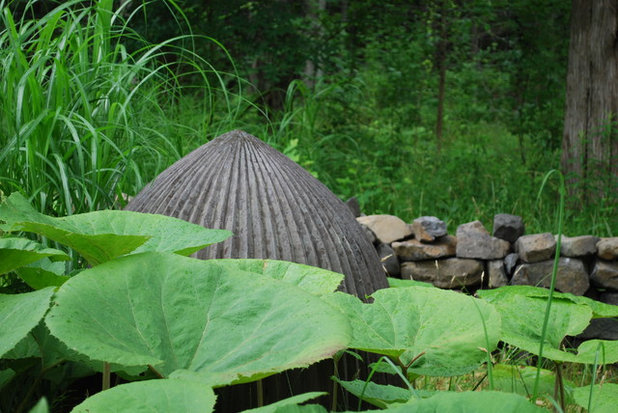
Jay Sifford Garden Design
The Garden at Federal Twist is appropriately dotted with sculptural elements that contrast the seas of foliage. This bronze sculpture by Mark Rosenquist, a neighbor of Golden’s, speaks to the coltsfoot’s foliage with regard to size and inverted shape, while forging a connection with the stacked-stone wall’s color and texture. This stone wall borders one edge of the garden.
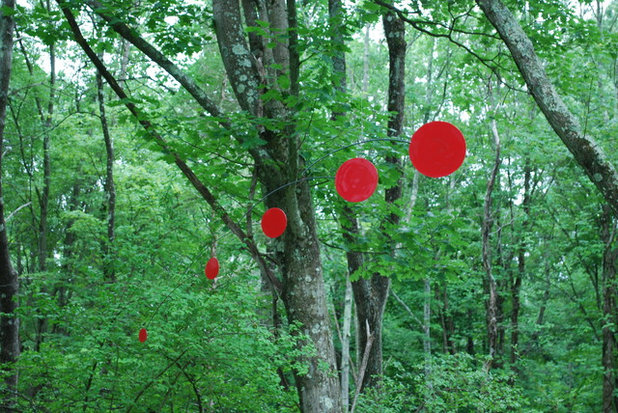
Jay Sifford Garden Design
This red kinetic art piece hangs high in the trees at the back of the garden. The contrast it creates with the complementary green foliage is memorable. The size gradation of each segment pulls the eye into the depths of the forest.
See how to make a real mobile
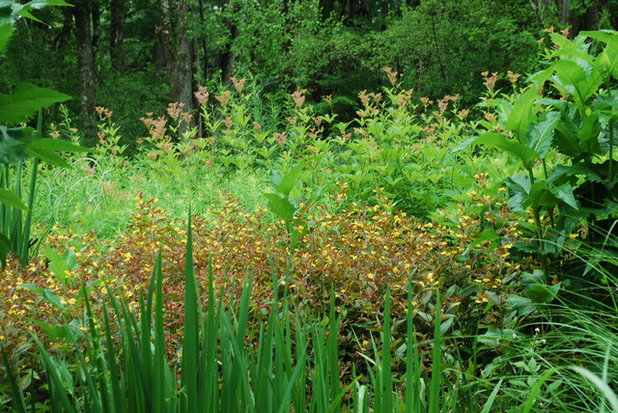
Jay Sifford Garden Design
Golden has created waves of texture and color throughout his garden. This vignette is a case in point: the ‘Firecracker’ fringed loosestrife (
Lysimachia ciliata ‘Firecracker’, zones 2 to 9) mimics the color of the queen of the prairie (
Filipendula rubra ‘Venusta’, zones 3 to 6) in the background. Golden compares these garden vignettes to ocean waves. They undoubtedly bring cohesion to this area that lies toward the center of the garden.
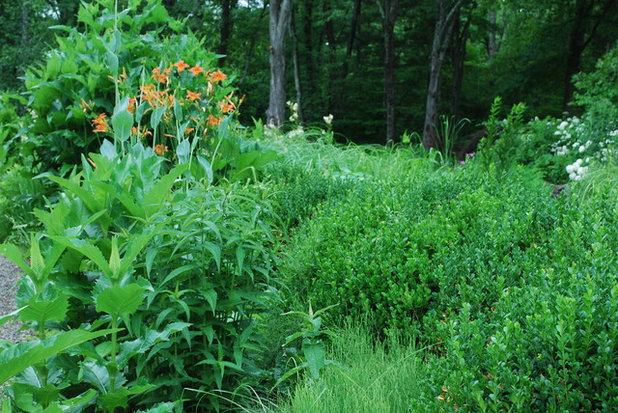
Jay Sifford Garden Design
Plants reminiscent of formal English gardens make intermittent appearances in Golden’s space. This installation of boxwood (
Buxus sp) sits atop an undulating mound in the center bog garden. They offer a subtle textural variation to the large perennials that thrive there.
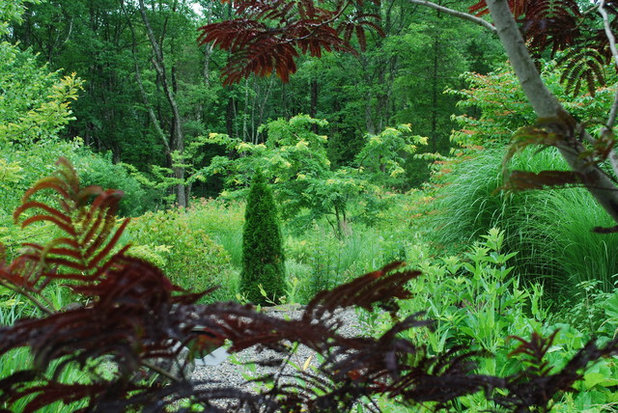
Jay Sifford Garden Design
Like the boxwoods, arborvitae (
Thuja plicata, zones 5 to 9) stand in stark contrast to their neighbors. Golden says that their presence “shows that all of this is intentional.” Their shape contrasts hardness and softness and, unlike most conifers, they thrive in wet clay. Installations of arborvitae appear as solemn figures in the rear of the garden.
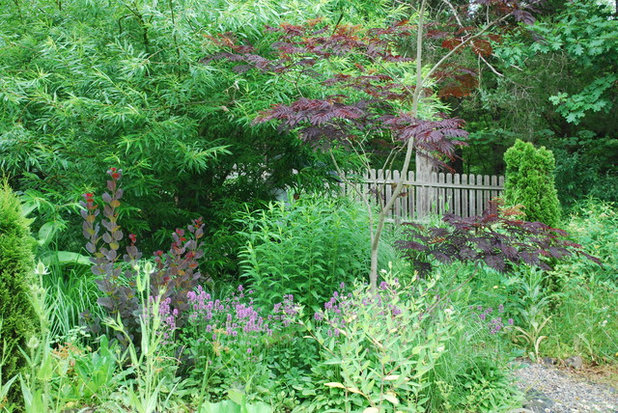
Jay Sifford Garden Design
Burgundy is woven throughout the garden in small doses. This vignette of ‘Summer Chocolate’ mimosa
(Albizia julibrissin ‘Summer Chocolate’, zones 7 to 10), shown on the right, and Grace smoke bush (
Cotinus ‘Grace’, zones 5 to 9), left, make a perfect foil for the planting of ‘Hummelo’ betony (
Stachys officinalis ‘Hummelo’, zones 4 to 8). This scene attracts interest near the rear terrace.
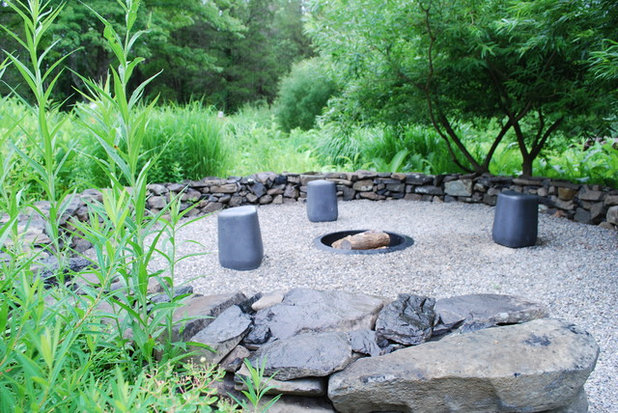
Jay Sifford Garden Design
Several hardscape features lie near the center of the garden, including this seating area with fire pit. This is part of Golden’s newer experimentation with compression. He describes compression as the experience of moving through an area that is tight with tall plants into an open area. The experience is notable when visitors walk through the center of the garden.
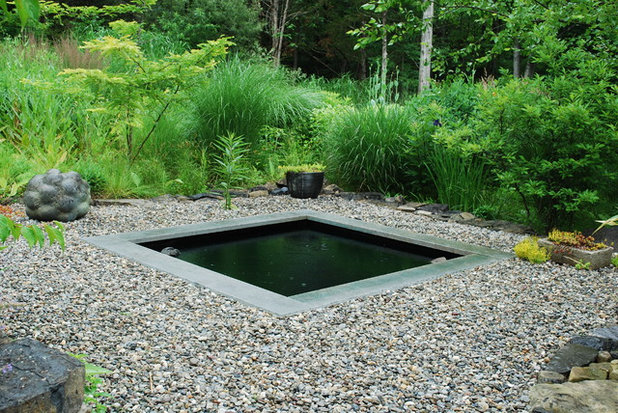
Jay Sifford Garden Design
The reflecting pool terrace, also near the center of the garden, is another one of Golden’s experiments with compression. This newer addition reads almost as a portal to another dimension. The water is still and dyed black. The dye, Golden says, keeps algae from becoming a problem. He also says the garden has plenty of frogs that take care of the pests, like mosquitoes.
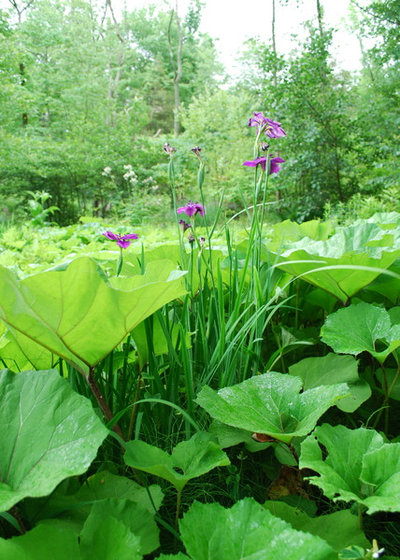
Jay Sifford Garden Design
Moments of serendipity, planned and not, punctuate Golden’s garden. Here, Japanese iris (
Iris ensata,
zones 3 to 9) raise their heads proudly through the spread of coltsfoot in the central bog garden.
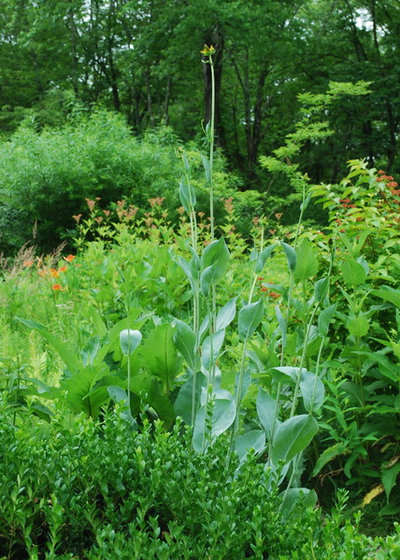
Jay Sifford Garden Design
Great coneflower, one of Golden’s original plants, rises high and stakes claim to this vignette. This prairie plant’s extensive root system provides it with unexpected durability in the wettest portion of the garden.
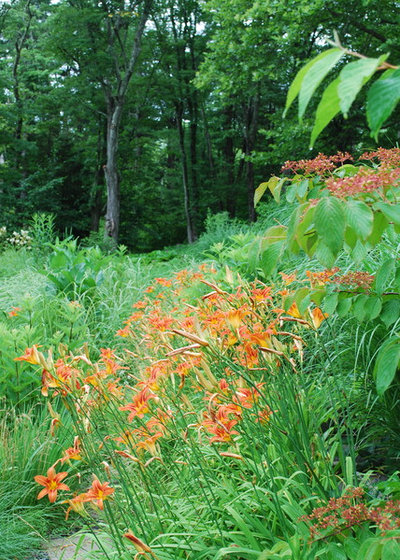
Jay Sifford Garden Design
Heading back toward the house, summer visitors encounter a hillside of orange daylilies (
Hemerocallis sp., zones 4 to 9). This variety is not the newest or grandest; rather, it is a common old-fashioned variety. Golden says he “tends toward simplicity and species instead of fancy selections.” These daylilies provide seasonal color as they grow through masses of maiden grass (
Miscanthus sp., zones 4 to 9). When the flowers are spent, the foliage fades back into its neighbors.
Golden makes an interesting observation when he says that the maiden grasses he has obtained from big-box stores seems to seed too freely, while the cultivars purchased from established plant nurseries seem to not.
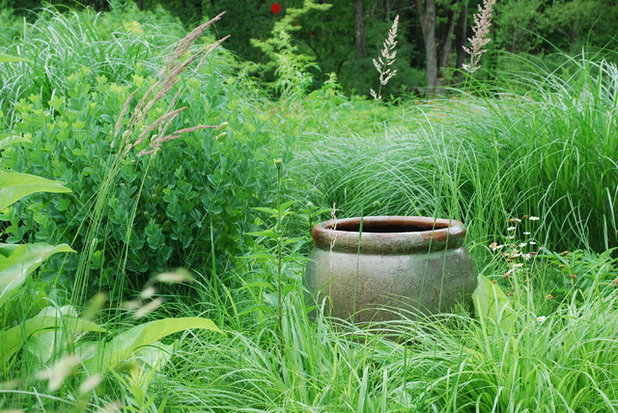
Jay Sifford Garden Design
Along the hill of maiden grass, a lone oversized ceramic pot offers textural relief.
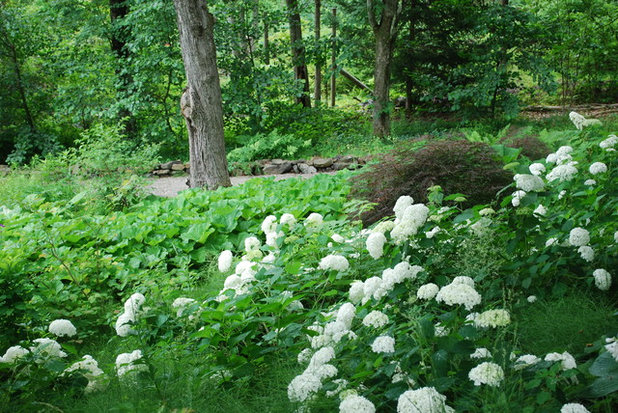
Jay Sifford Garden Design
On the shadier portion of the hill below the terrace, masses of ‘Annabelle’ hydrangeas (
Hydrangea arborescens ‘Annabelle’, zones 4 to 9) greet the garden visitor. Large heads of pure white flowers contrast with the sea of green foliage beneath.
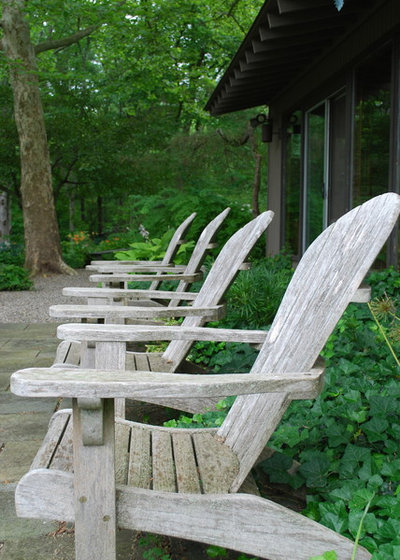
Jay Sifford Garden Design
The terrace stretches along the back of the house and overlooks the major portion of the garden. Here, Golden can survey his created paradise and observe how his garden looks as a whole. As a garden tour visitor, I was captivated by the row of wooden terrace chairs. The simple placement gives the chairs a rhythm and sculptural presence.

Jay Sifford Garden Design
Leaving The Garden at Federal Twist, I couldn’t help admiring the masses of ‘Othello’ leopard plant (
Ligularia dentata ‘Othello’, zones 4 to 8). For this visiting Southerner who grows these with difficulty, it was a worthy end to an unforgettable garden.





